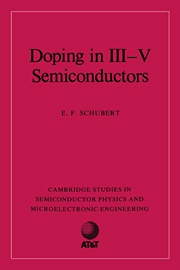Book contents
- Frontmatter
- Contents
- Foreword
- Preface
- List of symbols
- Introduction
- 1 Shallow impurities
- 2 Phenomenology of deep levels
- 3 Semiconductor statistics
- 4 Growth technologies
- 5 Doping with elemental sources
- 6 Gaseous doping sources
- 7 Impurity characteristics
- 8 Redistribution of impurities
- 9 Deep centers
- 10 Doping in heterostructures, quantum wells, and superlattices
- 11 Delta doping
- 12 Characterization techniques
- Appendix A Properties of III–V semiconductors
- Appendix B Constants and conversions
- References
- Index
2 - Phenomenology of deep levels
Published online by Cambridge University Press: 05 October 2010
- Frontmatter
- Contents
- Foreword
- Preface
- List of symbols
- Introduction
- 1 Shallow impurities
- 2 Phenomenology of deep levels
- 3 Semiconductor statistics
- 4 Growth technologies
- 5 Doping with elemental sources
- 6 Gaseous doping sources
- 7 Impurity characteristics
- 8 Redistribution of impurities
- 9 Deep centers
- 10 Doping in heterostructures, quantum wells, and superlattices
- 11 Delta doping
- 12 Characterization techniques
- Appendix A Properties of III–V semiconductors
- Appendix B Constants and conversions
- References
- Index
Summary
Deep levels are states within the forbidden gap of a semiconductor that are far removed from either conduction or valence band. Many of the deep levels are closer to the center of the gap than to either of the band edges. The name midgap center is frequently used for such deep levels. Due to their ability to capture free electrons and holes, deep levels are also called traps or deep traps. Deep levels caused by substitutional, non-hydrogenic impurities are referred to as deep impurities. Chromium in GaAs and Fe in InP are examples of such deep impurities. Finally, deep levels can be due to point defect centers. Examples of such deep centers are anti-site defects and interstitials.
Deep levels can be caused not only by point defects but also by spatially extended defects. Examples for extended defects are dislocations such as threading dislocations, misfit dislocations, or screw dislocations. Another example of extended ‘defects’ are semiconductor surfaces. Electronic states at semiconductor surfaces are called surface states or Bardeen states after Bardeen (1947) who demonstrated the influence of such states on the surface potential. In many semiconductors, Bardeen states are located in the vicinity of the center of the gap (e.g. GaAs and InP) and have properties similar to deep levels occurring in the bulk.
Deep centers can be classified according to their charge state. Centers with a neutral and positively charged state are called donor-like states.
- Type
- Chapter
- Information
- Doping in III-V Semiconductors , pp. 54 - 77Publisher: Cambridge University PressPrint publication year: 1993

